
Murcia is a city in south-eastern Spain, the capital and most populous city of the autonomous community of the Region of Murcia, and the seventh largest city in the country. It had a population of 460,349 inhabitants in 2021. The total population of the metropolitan area was 672,773 in 2020, covering an urban area of 1,230.9 km2. It is located on the Segura River, in the southeast of the Iberian Peninsula. It has a climate with hot summers, mild winters, and relatively low precipitation.
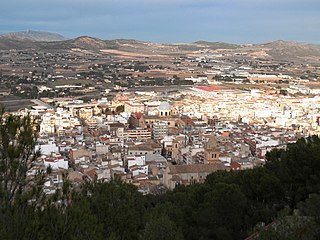
Yecla is a town and municipality in eastern Spain with 35243 people registered, in the extreme north of the autonomous community of Murcia, located 96 km from the capital of the region, Murcia.

Mazarrón is a municipality in the autonomous community and province of Murcia, southeastern Spain. The municipality has an area of 318.7 square kilometres (123.1 sq mi), and a population of 31,562 inhabitants in 2019. A military fort which was built between 1930 and 1936 during the reign of Alfonso XIII of Spain and the Second Spanish Republic exists as a tourist attraction on the old road between Mazarrón and Cartagena, and although it is accessible from the Bay of Mazarrón it is not in the municipality itself.

Totana is a municipality in the Region of Murcia in Spain. It has a population of 32008. The local economy is largely dependent on agriculture and related industries. It has a railway station providing a service on the Cercanías Murcia/Alicante commuter line, providing connections to Alicante and Murcia.

Calasparra is a municipality in the autonomous community of Murcia, Spain. It shares borders with Cieza, Mula, Cehegín, Moratalla and province of Albacete.

Abanilla is a Spanish municipality located in the Comarca Oriental in the Autonomous Community of Murcia. It lies close to the border of the province of Alicante in the Autonomous Community of Valencia.

La Unión is situated in the Region of Murcia in the southeast of Spain. It has an area of 24.6 km², and had a population of 19,907 on 1 January 2018. It has an elevation of 86 m. Its average annual temperature is 17 °C. It has balmy winters. The sun shines 320 days per year. La Unión is situated in one of the sunniest areas in Europe; this kind of climate makes possible the many leisure activities, popular fiestas, sports, and cultural activities that are held in the town. The town is linked by a regular train to Cartagena which allows views of the past industrial heritage of the area and the more modern occupations of agriculture and tourism. La Unión lies within the built-up area of Cartagena and is surrounded on all landward sides by the City of Cartagena.

Alcantarilla is a town and municipality in southeastern Spain, in the Autonomous Community of the Region of Murcia. The town is only 7 km away from the capital of the region, the city of Murcia, and one of its peculiarities is that it is completely surrounded by "pedanías" of the municipality of Murcia like Sangonera La Seca, San Ginés, Nonduermas, Puebla de Soto, La Ñora, Javalí Viejo and Javalí Nuevo.
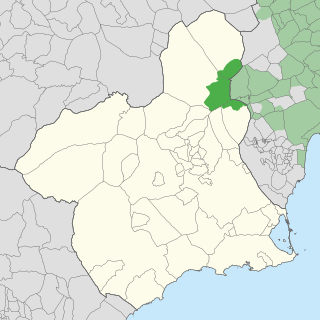
Carche is a mountainous, sparsely populated area in the Region of Murcia, Spain, lying between the municipalities of Jumilla and Yecla. The mountains reach an elevation of 1,371 metres at the Pico de la Madama and part of the region has the status of regional park. Three villages border the park: Raspay, La Alberquilla and Carche, with a total of 182 inhabitants (2005).
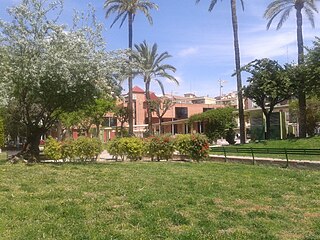
Molina de Segura is a municipality of Spain in the autonomous community and province of Murcia. It is located 10 km from the provincial capital, Murcia.

Tibi is a municipality in the comarca of Alcoià, Alicante, Valencia, Spain. The name of this municipality comes from Latin and it means "for you". This territory was populated with 1,564 people in the year 2018.

Fuente Álamo de Murcia is a town and municipality in the Region of Murcia, southern Spain. It is situated 22 km northwest of Cartagena and 35 km south west of Murcia. The town lies in the basin of the Mar Menor surrounded by the mountains of Algarrobo, Los Gómez, Los Victorias and the Carrascoy.
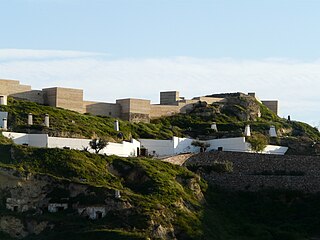
Puerto Lumbreras is a Spanish municipality in the autonomous community of Murcia. It has a population of 15,780 (2020) and an area of 139 km2. It is located in the southwestern end of Region of Murcia and is adjacent to Andalusia.
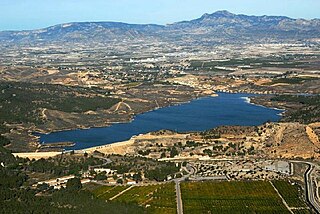
Santomera is a Spanish municipality in the autonomous community of Murcia. It has a population of 16,105 (2018) and an area of 44.2 km2. It shares borders with Fortuna in the north, with Murcia in its west and south and with the province of Alicante in the east.

Torre-Pacheco is a municipality in the autonomous community of Murcia in southeastern Spain. It covers an area of 189.4 km2 and its population in 2019 was 35,676. The only high ground in the municipality is Cabezo Gordo hill, the location of the protected Sima de las Palomas archeological site. The town has one secondary education institution, the I.E.S. Gerardo Molina.

The Region of Murcia is an autonomous community of Spain located in the southeastern part of the Iberian Peninsula, on the Mediterranean coast. The region is 11,313 km2 (4,368 sq mi) in area and had a population of 1,511,251 as at the start of 2020. About a third of its population lives in the capital, Murcia, and a seventh in the second city, Cartagena. At 2,014 m (6,608 ft), the region's highest point is Los Obispos Peak in the Massif of Revolcadores.

Aledo is a municipality in the Region of Murcia, southern Spain.

Cartagena is a Spanish city and a major naval station on the Mediterranean coast, south-eastern Iberia. As of January 2018, it has a population of 218,943 inhabitants. This makes Cartagena Murcia's second-largest municipality and Spain's sixth-largest city that is not a provincial-capital. The wider urban or metropolitan area of Cartagena, known as Campo de Cartagena, has a population of 409,586 inhabitants.
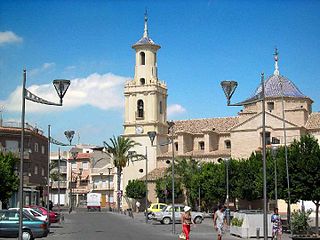
Fortuna is a town and a municipality in the autonomous Region of Murcia in southeastern Spain. It is located in the northeast of the region and in Comarca Oriental. The municipality shares borders with Abanilla at its east, Jumilla and Abarán at is north, Blanca at its northwest, Molina at its west and southwest and Murcia and Santomera at its south.

Los Martínez del Puerto is a village in Murcia, Spain. It is part of the municipality of Murcia.























